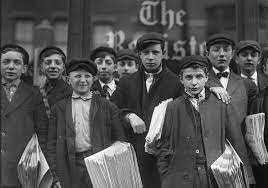By Chloe Brussard
Newsboys, or Newsies, were given their iconic name for being newspaper distributers. Morning editions of the daily papers were delivered directly to their subscribers, but the afternoon editions relied completely on newsboys to sell them out.
There were several newsboys strikes several years before the dramatic and more well known strike of 1899. These previous strikes started and took place in 1886 and 1887, with the final one in 1889. The final strike that the newsboys held against the World and the Journal was in August of 1899.
With the Spanish American War increasing their newspaper sales, most publishers raised the cost of a newsboy's bundle of 100 papers from 50 cents to 60 cents, which at the time was a lot of money. This was a price increase that at the time was offset by the increased sales.
After the war, many papers reduced the cost back to previous amount, with the exceptions of The Evening World and and New York Evening Journal, which was the cause of the beginning of the chaos.
The Early Days of the Strike
On July 18, 1899, a group of newsboys in Long Island turned over a distribution wagon for the New York Journal and declared a strike against the papers of the publisher of the World and the publisher of the Journal, until the prices were out back to 50 cents per hundred papers.
The following day, July 19, the newsboys of Manhattan and Brooklyn reenacted the same actions as the Long Islanders from the day before.
The newsboys methods were very violent. Any man or boy found to be selling the two boycotted papers would be mobbed by a group of strikers, beaten, and had their papers destroyed. The newspaper owners paid grown men to sell their papers while offering them police protection, but the strikers found ways to distract the officers so they could still attack.
The newsboys held a city-wide rally on July 24, 1899 with over 5,000 boys from Manhattan and 2,000 boys from Brooklyn, all sponsored by state senator Timothy D. Sullivan. Many local businessmen and politicians addressed the crowd at Irving Hall. When the adults had finished speaking, union president David Simmons read a list of resolutions saying that the strike was to stand until the papers reduced their prices, but also calling on the newsboys to adopt non-violent methods of resistance.
After the Rally
In the few days following the rally, the newsboys' changed to be 'non-violent'. Even though they were no longer beating people who sold the World and the Journal, the strike was still effective since by then the public was on their side and chose not to buy then even if they were for sale.
On July 26, 1899, the newsboys planned a parade where 6,000 boys would march with a band and fireworks, but the parade never actually happened due to issues with getting a permit.
On the same day that the parade was planned, rumors spread among the newsboys that their strike leader Kid Blink had betrayed the strike and agreed to sell the boycotted papers in exchange for a bribe from the newspaper executives. He denied the charges, but some source did notice that he wore clothes that were a bit nicer than his usual, indicating that there was a possibility that he may have accepted the bribe money. In response, Kid Blink resigned from his leadership position, becoming a walking delegate.
That night, Kid Blink was chased through the streets by a group of boys who were very angry about the rumors that he had left the strike. A police officer assumed that it was Kid Blink who was the leader and arrested him for disorderly conduct. He was given a fine and then let go, while a group of newsboys outside the court mocked him.
The End of the Strike
After the rumors of Kid Blink, the newsboys faith in leadership fell dramatically. Other newsboys did try to step up to lead the strike, but none of them had the same level of power that Kid Blink once had. Finally, on August 1, 1899, the World and the Journal offered the newsboys a compromise, which was that the price of the one hundred papers would stay at 60 cents, but the newspapers would buy back any unsold papers.
This meant the boys who had trouble selling all their papers would not be forced to sell late into the night. The Newsboys accepted this compromise, ending the strike and getting rid of the union on August 2, 1899.






No comments:
Post a Comment